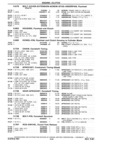1964 clutch problem continues
Collapse
X
-
Re: 1964 clutch problem continues
Jack, how about some of those promised pictures. One of the clutch pedal where the clutch rod connects to it. One of the cross shaft and where the clutch rod connects to it. One of the clutch fork and the rod from it to the cross shaft.
When was your original post and original problem presented. Scott- Top
-
Re: 1964 clutch problem continues
Jack,
Is your clutch disk a flat finger or bent finger design?
Is your bearing the tall or short version?
Rich- Top
Comment
-
Re: 1964 clutch problem continues
, pics of bearing info- Top
Comment
-
Re: 1964 clutch problem continues
- Top
Comment
-
Re: 1964 clutch problem continues
Jack,
Ok, you have correct Corvette bent finger clutch disk.
But I think your latest bearing is too wide(tall).
When I get back to the laptop I need to check some references. Please wait for my reply in a bit.
Rich- Top
Comment
-
Re: 1964 clutch problem continues
So the cross reference shows GM# 908093 which is for 1964 Corvette, but the GM spec is 1.25" W, not 1.5".
The Rock Auto part(#?) shows 1.246". This is the correct size.
Is there a stamped number on the Rock Auto supplied bearing?
I'm thinking someone mislabeled the box, or put the wrong part in the right box.
Rich- Top
Comment
-
-
Re: 1964 clutch problem continues
Jack, Let's think about this a bit more before pulling everything apart...
I had to go back to your post#1. It's NOT disengaging(not releasing).
For that to happen, it's telling me that the bearing is NOT pressing enough on the clutch plate fingers to release disk pressue. If the bearing is too SHORT, I could see this happening. It would be like using a Flat Finger clutch with a "Short" bearing. I.E. ...Not enough throw distance, can't press the finger springs, and can't disengage.
Now in your case, your new bearing is 1/4" "Taller" than the old one. This means it would compress the fingers of the disk sooner, disengaging it maybe a bit sooner.
Where I'm going here is this. I think your bearing may be okay, but your problem of not disengaging may be caused by a something else and may be a simple solution.
I think your fork may not be properly installed on the pivot ball in the bell housing. If the fork isn't properly snapped over the ball held in by the clip, it would change the geometry enough to prevent proper fork/bearing throw. There wouldn't be enough throw to press the bearing to force the finger springs to release the disk.
Also, your image you posted earlier may be a smoking gun now that I see it again more closely....
The bearing contact face is too far away from the fingers. Maybe you loosened the fork rod before the photo, but If you didn't, this isn't right. The bearing contact face should be just slightly off the fingers under normal at-rest clutch engagement(bearing released from fingers).
61C6F97A-0100-47BB-B6D5-417A27F5D939.jpg
It's also important to have the fork fingers properly capturing the bearing groove, but I think you have that covered now from your earlier thread with Joe's posted link and Leif's diagram. Here.
Repost...
IMG_3612.jpg
See if you can get your borescope in the fork opening to check fork to pivot ball contact. Pay close attention to the spring clip placement too.
If you find it's fork related, release the z-bar to fork rod and grab the fork and see if you can snap it back over the ball. Put the rod back on, set your pedal free play to spec and test the clutch again.
Rich- Top
Comment

Comment